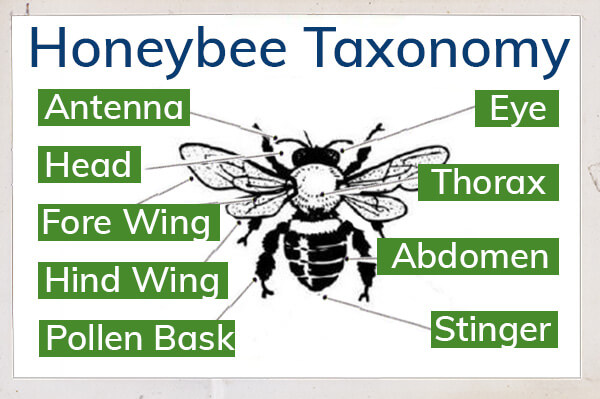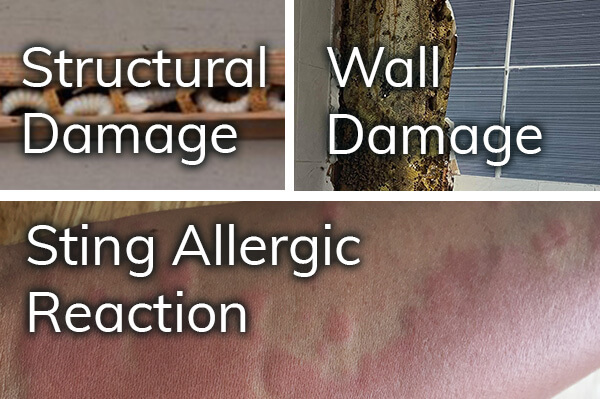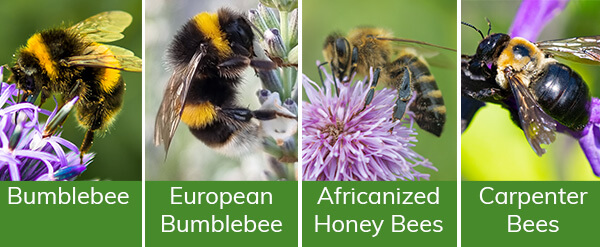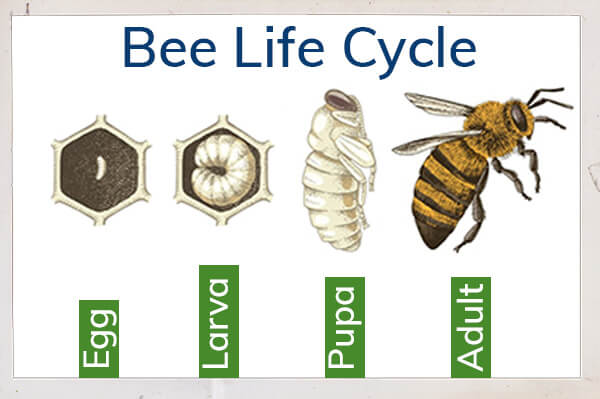Bees are one of the most common residential pests in California, can be difficult to remove without professional help, and can be dangerous since most bee species are capable of stinging people, causing painful reactions that can sometimes be fatal. They often enter residential areas in search of food sources, shelter and protection from predators. As a homeowner, it is important to understand why bees become pests, the potential danger they pose to humans and how best to prevent them from entering your home or property.
Since bees play a vital role in our ecosystem by pollinating plants and producing honey, it’s important to handle them with care and identify safe ways for their removal. If you observe a colony on your property or inside residential structures, you should contact a local residential pest control professional for assistance before attempting self-removal. Professional technicians typically have the necessary tools and expertise needed to safely remove bees from residential areas without harming them or putting people at risk.
Being aware of the risks associated with residential bee infestations is essential for any homeowner in Southern California who wishes to protect their property and loved ones from harm. Understanding why bees become residential pests and knowing how best to prevent their invasion is crucial for maintaining a safe living environment.
Bee’s Appearance

Bees are incredibly diverse creatures, with over 25,000 known species found on Earth. Each type of bee has its own unique traits and characteristics that homeowners should be familiar with in order to have an effective residential pest control program. Most bees have an exoskeleton and three distinct body parts: the head, thorax, and abdomen. They also have antennae and three pairs of legs, with pollen baskets often located on the back legs. In terms of size, a honeybee can range from 0.5 to 0.8 inches in length – but this is just one example among thousands of species!
The most iconic image of a bee is that of a black and yellow winged creature with a pointy black stinger; however, not all bees share the same attributes. Some may be striped or brownish in color, while others may feature different sizes and shapes of stingers. Alongside residential pest control programs for other pests like ants, spiders, cockroaches, silverfish, pincher bugs and crickets, it’s important for homeowners to familiarize themselves with the various types of bees that may pose a threat so they can seek out professional help if necessary.
Black and yellow. Winged. Pointy black stinger. For many people, this is the only image of a bee they have. And, while this appearance is standard for the western honeybee, not all bees share the same traits. In fact, there are over 25,000 species of bees in the world, each with its own unique characteristics. In general, bees have an exoskeleton and three main body parts– the head, the thorax, and the abdomen. Bees also have antennae and three pairs of legs, and most types of bees will have pollen baskets on their back legs. As for size, a species like a honeybee can range from 0.5-0.8 inches in length.
Are bees serious?
Residential homeowners should know about the potential dangers posed by bees’ presence around and in their home. Although bees play a vital role in pollination, potentially leading to better-tasting fruits and vegetables, they can also become a residential pest if not properly managed.
Bees have stingers that contain venom and can cause painful welts when stung. Depending on an individual’s reaction to the venom, a bee sting may require medical attention or even induce anaphylaxis, which is a severe and potentially life-threatening allergic reaction. Africanized honey bees in particular are known for their more aggressive behavior and should not be approached without professional assistance.

The presence of bees in residential areas can become especially dangerous when they build hives near homes or other residential buildings. Bee infestations can occur inside walls or attics of residential buildings, creating a potential hazard to those living nearby as well as damaging property with their hive-building activities. If left unaddressed, bee infestations may also attract other pests such as wasps or rodents looking for easy access to the sweet nectar that bees produce.
In order to protect residential properties from bee infestations, homeowners should take preventative measures to detect any signs of activity from bees and allow residential pest control professionals to provide assistance with identifying potential danger zones around residential properties as well as effective removal solutions for existing bee hives.
How do bees enter my home?
Bees can enter a residential home quite easily if the homeowner is not careful. Although bees can fly through open windows and doors, they can also use other spaces to gain access to a residential home such as vents, chimneys and any gaps in walls. If a bee finds its way in it is usually easy to remove them if they have not been able to establish a hive yet; however, if a hive has been established then residential pest control action is required.
Bee hives are usually created when bees find an area inside the residential home that produces enough warmth and protection for them to nest, such as the gap between two walls or in an attic. The hives they create will contain thousands of bees which pollinate flowers but also produce irritant pheromones – this makes them hard to identify until their presence can be felt or noticed.The best way for homeowners to avoid bees entering their homes is by being vigilant about inspecting any cracks or gaps in the walls and fixing them immediately, as well as avoiding leaving open doors and windows for too long during warm weather. If you suspect that bees may have entered your home then it’s important to contact residential pest control services who will be able to help you safely remove the bees without causing any harm.
Types of bees in Southern California

Bee species are varied in Southern California, with native bees such as the mining bee and invasive bees like the Africanized honey bee. Bumblebees, European Bumble Bees, Africanized Honey Bees and Carpenter Bees are all commonly seen in residential areas of Southern California. Many people don’t realize that each type of bee is different and requires specific control measures to be effective.
Bumblebees are the most recognized bees, which can be identified by their black and yellow striped bodies. They typically nest underground or in hollow trees and help pollinate a variety of plants. Bumblebees are not considered aggressive but will sting if threatened or disturbed. It’s important to note that bumblebee nests should never be disturbed or destroyed since they play an important role in local ecosystems.
European Bumblebees have similar color patterns to bumblebees but can easily be distinguished by the white tips on their abdomens. Though they look similar to the common bumblebee, European bumble bees are classified as an invasive species due to their aggressive behavior and potential for displacing local species with hybridization. As such, residential pest control companies often use special techniques when dealing with these bees.
Africanized honey bees have become increasingly more common in residential areas of Southern California in recent years due to their ability to build hives in residential homes such as attics, under decks and even inside walls. These bees are highly protective of their hives and will aggressively defend them when threatened, making them a dangerous pest if left unchecked. Homeowners should always contact professional residential pest control services if they suspect an Africanized honey bee hive has been established near their home due to the risk posed by these pests.
Carpenter bees resemble bumblebees but lack stripes on the abdomen which makes them distinct from other types of bees found throughout Southern California residential areas. Unlike other types of bees, carpenter bees bore through wood and create tunnels where they lay eggs inside walls or wooden structures creating long-term damage to property if left untreated by residential pest control professionals.
Life cycle and reproduction
The life cycle of bees is an important and fascinating process, with each stage having a unique purpose. The egg is the first step in the cycle, where it is laid by the queen bee. Depending on whether it is fertilized or not, this egg will develop into either a male drone bee or a female worker bee. From there, the eggs will hatch and become larvae, which are unable to move independently and rely on their fellow bees to feed them. After several days of feeding, the larvae will enter a cocoon and become pupae. At this stage they have developed wings, antennae, and legs but remain immobile as they continue to mature and gain strength. Finally, they emerge from the cocoon as an adult bee ready to begin their role in maintaining the hive and gathering pollen for food.

It’s important to note that while this process may take only 16 days in some species of bees, residential pest control experts recommend allowing up to 3 weeks before bees can be considered fully mature adults – meaning that any residential pest control activities must be carefully planned around this timeline for maximum effectiveness. In addition to residential pest control strategies such as treatments and traps, it’s also important to know how reproduction affects bee populations over time in order to ensure healthy colonies into the future. For example, queen bees can lay anywhere from 2000-3000 eggs per day – when combined with other factors such as lifespan or mortality rates due to pests or diseases – this has potential implications on population size that residential pest controllers need to understand when considering residential pest management strategies for bees.
Bee behavior and diet
Bees are a type of residential pest that can be found in residential areas throughout the world. They can vary in size and color, but they are all known for their hard working nature and dietary habits. Honey bees feed off of flower nectar, as well as sweet human food like soda or fruit juice due to the source of sugar they provide. Generally speaking, bee behavior is quite docile and they will not attack unless they feel threatened or perceive danger to their colony. However, some species such as Africanized honey bees are more aggressive and may become agitated very easily.
When bees create large colonies or the queen bee begins to show signs of weakening, they will swarm together and relocate as a group to start a new hive. This process is a vital part of bee reproduction and it helps maintain healthy populations in residential areas. Understanding bee behavior and diet is essential for residential pest control since being aware of potential infestations can help protect homeowners from harm. Taking steps like regularly inspecting residential areas for potential nesting sites or installing screens around windows can help deter honey bees from entering residential properties.
Bee control
Bees will fight to protect their colony and can reproduce at an alarming rate; therefore, it’s essential to get quick control over a bee infestation on your property. Some ways to protect your property from bees include:
- Calling a beekeeper or professional pest control company: As some species of bees are helpful for the environment, professionals can help safely remove these bees and move them to a more suitable location.
- Removing access to sweets, food, and water: Bees will be less tempted to linger on your property if they don’t have access to sources of food and water.
- Keeping flowering vegetation away from your highly frequented areas: plants of flowers should be kept away from places like decks, sidewalks, and mailboxes.
- Seal up all cracks and crevices around your home where bees can enter and establish a hive.
Overall, understanding bee behavior is key when it comes to residential bee infestation pest control. By taking precautionary measures such as limiting their access to sweet substances and sealing entry points into your home, you will help protect yourself from bee stings and unwelcome hives near your residential property.
Work together with AIPM to effectively handle any and all types of bee problems on your property. Call us at 888-344-6567 or request a quote to keep your home safe and bees safely outside with AIPM’s comprehensive pest control services.
